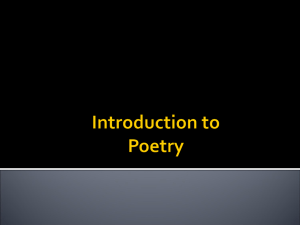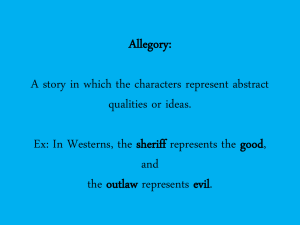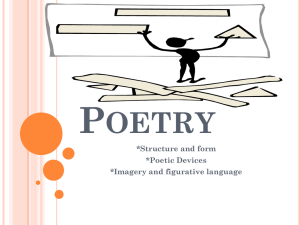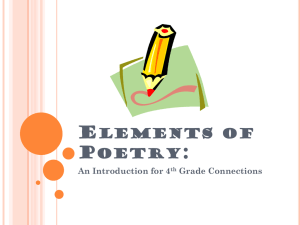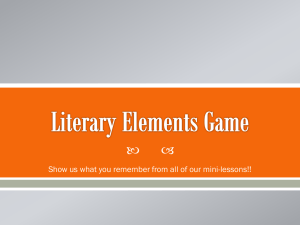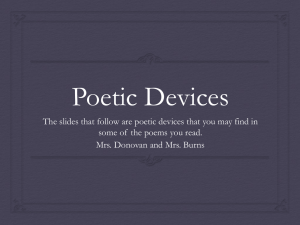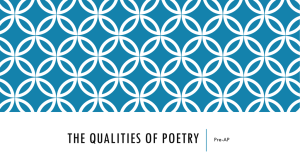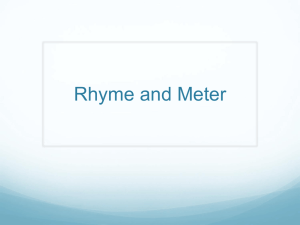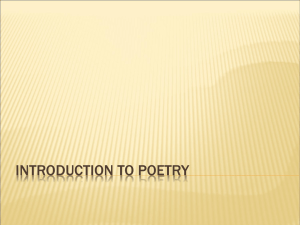Poetry
advertisement
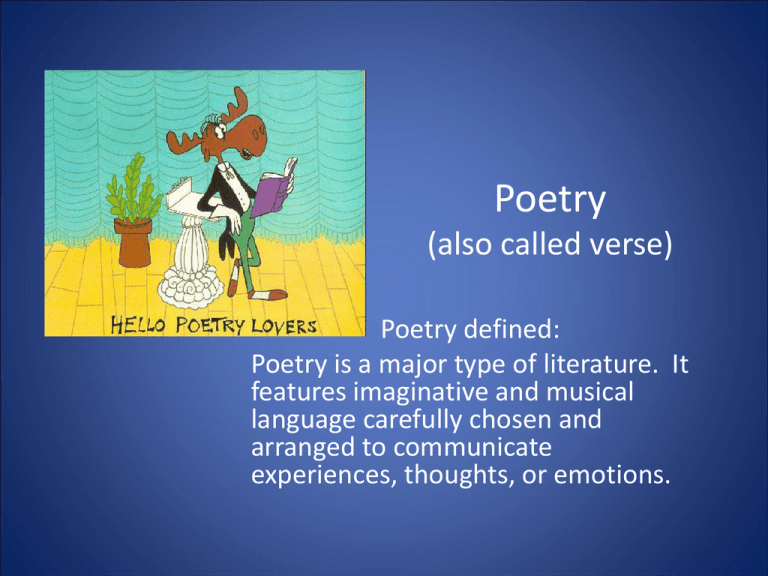
Poetry (also called verse) Poetry defined: Poetry is a major type of literature. It features imaginative and musical language carefully chosen and arranged to communicate experiences, thoughts, or emotions. Characteristics: • Poetry differs from prose in that it compresses meaning into fewer words and often uses meter, rhyme, and imagery. • Poetry is usually arranged in lines and stanzas as opposed to sentences and paragraphs and it can be more free in the ordering of words and use of punctuation. Sound Effects Alliteration Rhyme Rhythm Meter Internal rhyme Onomatopoeia Rhyme scheme Consonance Assonance Repetition Repetition The use of the same words or phrases over and over Alliteration The use of words that begin with the same sound Example: “Peter Piper picked a peck of pickled peppers.” Onomatopoeia The use of words that sound like the thing they describe Examples: “hiss,” “boom,” “buzz” Meter Meter is a regular rhythmic pattern in poetry. This pattern is determined by the number of beats, or stresses, in each line. Stressed and unstressed syllables are divided into rhythmical units called feet. Types of Feet: • Iambic – an unstressed syllable followed by a stressed syllable (Example: insist) • Trochaic—a stressed syllable followed by an unstressed syllable (Example: freedom) • Anapestic—two unstressed syllables followed by one stressed syllable (unimpressed) Types of Feet continued • Dactylic—one stressed syllable followed by two unstressed syllables • Spondaic--two stressed syllables Terms used to describe the number of feet in a line: • Monometer—one foot line • Dimeter—two-foot line • Trimeter—three-foot line • Tetrameter—four –foot line …continued • • • • Pentameter—five-foot line Hexameter—six-foot line Heptameter—seven-foot line Octameter-eight-foot line • Note: The most common meters are iambic tetrameter and iambic pentameter. Types of Rhyme: • End rhyme—use of rhyming words at the ends of lines • Internal rhyme—the use of rhyming words within lines • Exact rhyme--rhyming words end with the same sound as in moon and June …continued • Slant rhyme—rhyming sounds are similar but not identical as in “rave” and “rove” • Sight rhyme—words are spelled similarly but pronounced differently, as in “lost” and “ghost” or “give” and “thrive” Rhyme Scheme the pattern of end rhymes designated by assigning a different letter of the alphabet to each rhyme (Ex: ababc) Poetic Forms: Lyric (ode, sonnet, ballad, elegy) Narrative --Shape poem Epic --Acrostic Haiku Blank verse Free verse Limerick Quatrain Cinquain Diamante Lyric a highly musical type of poetry the purpose of which is to expresses the emotions of a speaker. Lyric poems often uses regular meter Ode a poem that’s purpose is to honor or praise someone or something. Sonnet a fourteen-line lyric poem, usually in iambic pentameter, that follows one of a number of different rhyme schemes, considered a “little song,” as sonnet’s purpose is to express thoughts, ideas, or feelings Epic a long narrative poem, usually chronicling the deeds of a folk hero and written using moth dramatic and narrative literary techniques. (The Odyssey, The Iliad, Paradise Lost) Free Verse Poetry that does not use regular rhyme, meter, or stanza division. Free verse may contain irregular line breaks and sentence fragments and the purpose of this irregularity is to mimic the rhythm of ordinary speech. Most contemporary poetry is written in free verse. Darn the electric fence! Darn Darn the electric fence! Haiku A form of Japanese pattern poetry, usually consisting of three lines in which the syllables alternate in a pattern of 5-7-5; Haiku reflects on some aspect of nature and uses a “minimalist” (simplified) form. Haiku Example An old silent pond A frog jumps into the pond, splash! Silence again. Haiku Squirrel crossing street Car comes, he changes his mind Be wise, not reckless. --Bonnie Best Elegy a poem that’s purpose is to express sorrow over a loss Limerick A short, humorous poem composed of five lines. Lines 1, 2, and 5 have seven to ten syllables and rhyme with one another. Lines 3 and 4 have five to seven syllables, and also rhyme with each other. Example Limerick There was an Old Man of Nantucket Who kept all his cash in a bucket. His daughter, called Nan, Ran away with a man, And as for the bucket, Nantucket. Example Limerick There was an Old Man with a beard Who said, “It is just as I feared! Two owls, and a hen, Four larks, and a wren Have all built their nests in my beard!” --Edward Lear from A Book of Nonsense Quatrain A poem of four lines: lines 2 and 4 must rhyme; lines 1 and 3 may or may not rhyme. Rhyming lines should have a similar number of syllables. Example Quatrain Life is good In many ways Just don’t get misunderstood On hard days Will Bjordammen Example Quatrain What’s wrong with people today? People are rude, Or maybe they’re in a mood, Or maybe it’s just too many attitudes. Example Quatrain I had once made a snowman Handsome as can be In the snow he melted A sad sight to see Sebastian Gusman Example Quatrain Apples, pears, cookies too Tacos, pizza, French fondue People, racecar, how are you? Ghost, goblins, zombies, BOO! Cinquain Has five lines: Line 1 is one word (the title), line 2 is two words that describe the title, line 3 is three words that tell the action, line 4 is four words that express feeling, line 5 is one word that recalls the title Example Cinquain Mules Stubborn, unmoving Braying, kicking, resisting Not wanting to listen People by Cindy Barden Example Birds Colorful, poised Flying, singing, diving Spirited, peaceful, joyous, free Dancers Abby Guinan Diamante Has seven lines line 1 is a one-word subject that is opposite of line 7 line 2 is two adjectives which describe the subject in Line 1 Line 3 is three verbs relating to the subject in line 1 line 4 is two nouns related to the subject of line 1, followed by two nouns related to the subject in line 7 (four words total) line 5 is three verbs related to the subject in line 7 line 6 is two adjectives which describe the subject in line seven line 7 is a one-word subject that is opposite of line 1 Example Diamante Tears Wet, shiny Sliding, escaping, holding, Girls, hearts, boys, teeth Healing, rejuvenating, motivating Beautiful, emotional Smile Alex Lewis Example Diamante Society Imperfect, unestablished Cheating, lying, stealing Pollution, economy, life, generations Greening, blossoming, growing Beautiful, majestic Nature Abby Guinan Shape Poem Poetry written in the shape or form of an object. This is a type of concrete poetry. Shape poem It smells like a box. It looks like a box. It tastes like a box. It sounds like a box. But it’s not a box. Amy Levy Acrostic Poem • A poem that makes a word or message from the first (usually) letter used in each line Living Inside the world For many years Everyday we learn something about it Graphic and Structural Elements • Line break—the intentional end of a line of poetry • Refrain—group of words repeated at key intervals in poetry • Stanza—division of a poem composed of two or more lines characterized by meter, rhyme, and number of lines Stanza Lengths • • • • • Couplet—two-line stanza Triplet—three-line stanza Quatrain—a four-line stanza Quintet—a five-line stanza Sestet—a six-line stanza Literary Language and Devices Hyperbole Metaphor Extended Metaphor Apostrophe Oxymoron Paradox Imagery New Literary Terms • Enjambment – the running over of a sentence from one line to the next (chops up the ideas/reader’s thoughts) • Antithesis—contrast of ideas by means of parallel arrangements of words, clauses, or sentences (Example: “You win some; you lose some.”) Apostrophe addressing an absent person or personified thing Oxymoron a combination of contradictory words, as in “cruel kindness” or “loving hate” Paradox A statement that is seemingly contradictory to common sense and yet is true Examples: I’m alone in a crowd. Water, water everywhere nor any drop to drink I must be cruel only to be kind. Paradox examples • I always tell lies. • We must go to war to make peace. • I can resist anything except temptation Imagery/Sensory Details A description that creates clear pictures in the reader’s mind; appeal to the five senses. When you read a description of something that causes you to imagine the way something tastes, smells, sounds, feels, or looks like idiom • An expression that has a meaning different from the meaning of its individual words • Examples— “to go to the dogs” “a drop in the bucket” “chip on your shoulder” “a piece of cake” “a pat on the back” “a slap on the wrist”

